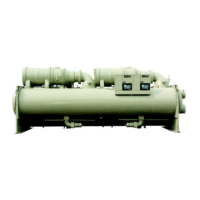Product Manual PM WSC/WDC 53
Motor Starters
McQuay has a wide variety of starter types and options to fit virtually all applications. The specifics of the final
selection of size and enclosure are covered in the product manual PM Starters. Please consult the local
McQuay sales office or this manual for starter details. This section contains a general overview only.
Mounting Options
Factory furnished, factory mounted; on vessel stacks larger than E3616/C3016, the starters are shipped loose
with cable kits and mounting brackets for field installation on the units by others.
Factory furnished, floor mounted; drop shipped to job site for setting and wiring by others.
Furnished by others; must meet McQuay Starter Specification and be approved by McQuay Engineering.
Low Voltage Starters (200 through 600 volts)
Standard equipment
Low voltage starters are continuous duty AC magnetic type with air break contactors. Enclosures are NEMA
1A, gasketed door, with top cable entry (bottom entry optional). Main control relays are redundant with coils in
parallel and contacts in series. Included are overload protection, phase failure and reversal protection, stall
protection, undervoltage protection and control transformer.
Wye-Delta closed transition
This starter (sometimes called “Star-Delta”) is the most popular type for centrifugal chiller applications. It
reduces inrush current by first connecting six motor terminals in a “Wye” configuration to reduce the maximum
inrush current to 33.3% of locked rotor amps and producing 33.3% of normal starting torque. After a brief delay,
the electrical load is momentarily transferred to resistors while the motor terminal connections are changed to
the delta configuration. The resistors minimize the second inrush current when the Delta leads becomes active.
Open transition starters (without resistors) are not recommended.
Autotransformer
This starter type uses a transformer with 50%, 65%, and 80% taps. The taps determine the initial voltage and
resulting inrush amps that will reach the motor. For centrifugal compressors, the 65% tap is used allowing 42%
of normal inrush current and generating 42% of starting torque. The 50% tap will usually not generate enough
starting torque and the 80% tap allows unnecessary inrush (64% of LRA). After a designated time period, a
bypass contactor closes allowing normal current to flow to the motor and removes the transformers from
service. There is little reason to use autotransformer type starters with centrifugal compressors, except for
applications where it is desirable to have the same type of starter throughout a facility.
Solid state starters
The solid state starters are another excellent type of starter for centrifugal compressors. This starter uses solid
state switching devices called SCRs (Silicon Controlled Rectifiers) that control the flow of current to the motor
during start up.
The SCR’s control the amount of voltage that reaches the motor which in turn controls the motor’s acceleration
and current inrush. Eventually, full voltage is applied and a bypass contactor is energized. The bypass
contactor, which is standard in the McQuay solid state starters, removes the SCR’s from service and eliminates
SCR losses and heat buildup while the unit is operating. Although setpoints are determined by the compressor
size, motor characteristics and starting torque, requirements usually are a minimum of three times the RLA for
the compressor’s specific application.
Solid state starters are generally used in applications where it is desirable to provide precise control of motor
starting characteristics. The inrush current can sometimes be reduced below Wye-Delta starters in severely
limited utility electrical distribution systems.

